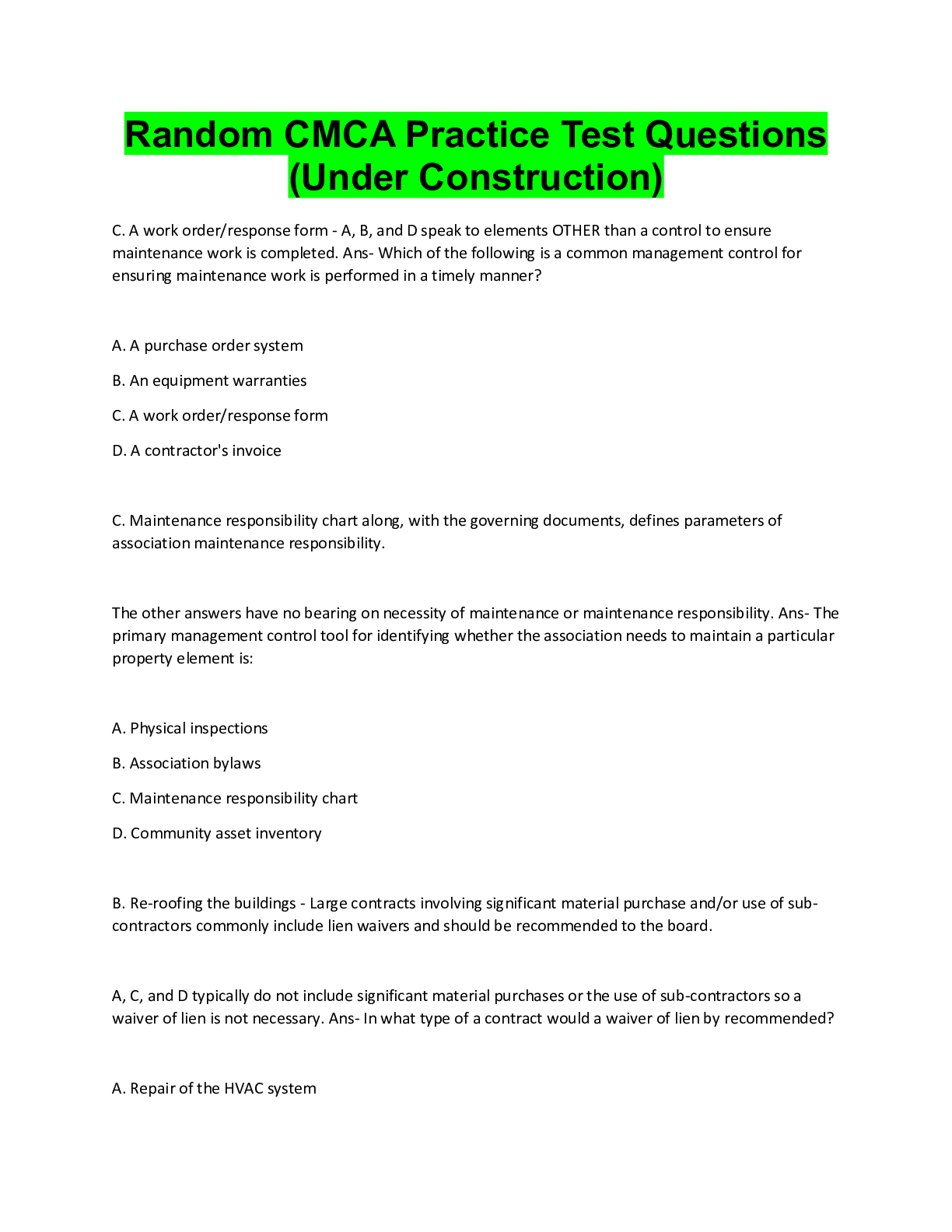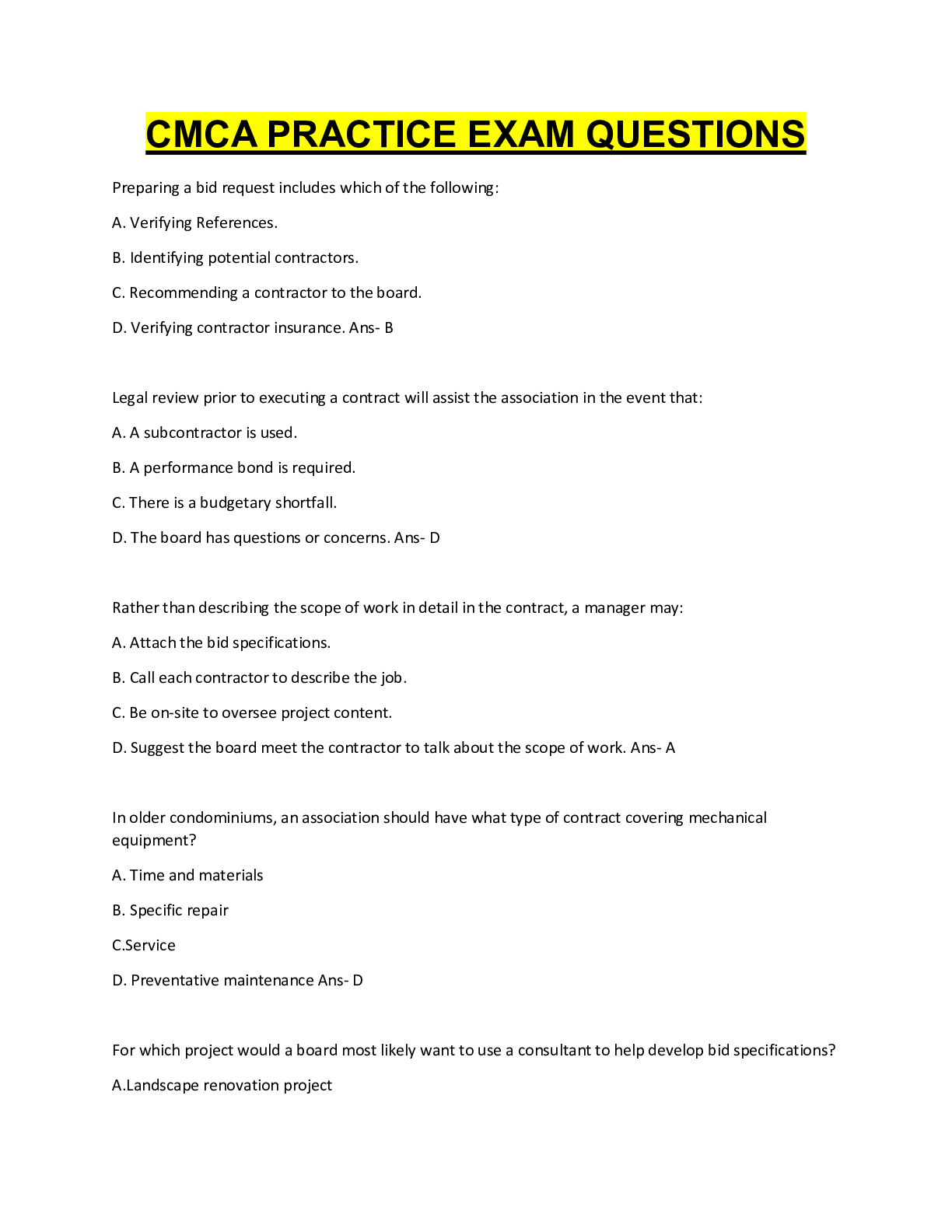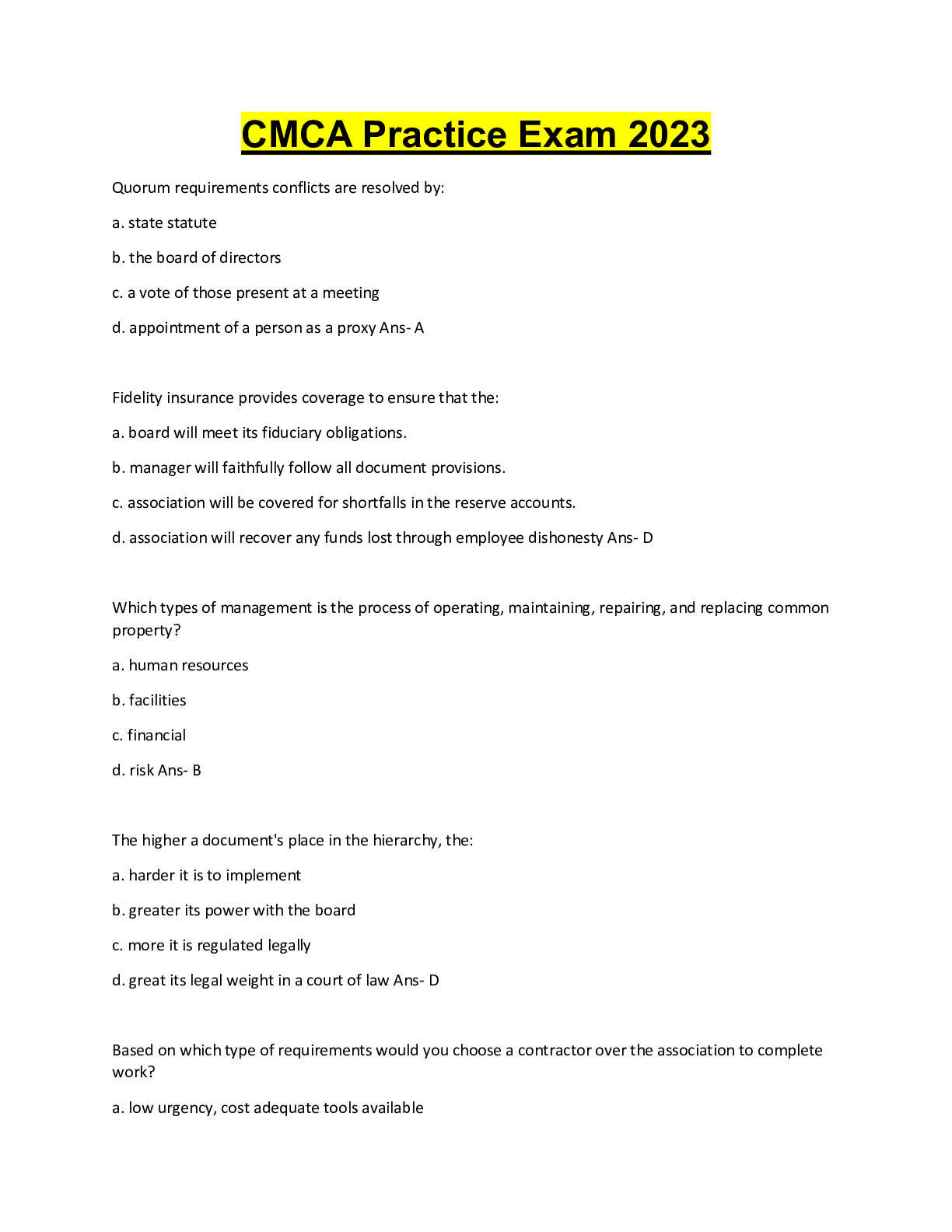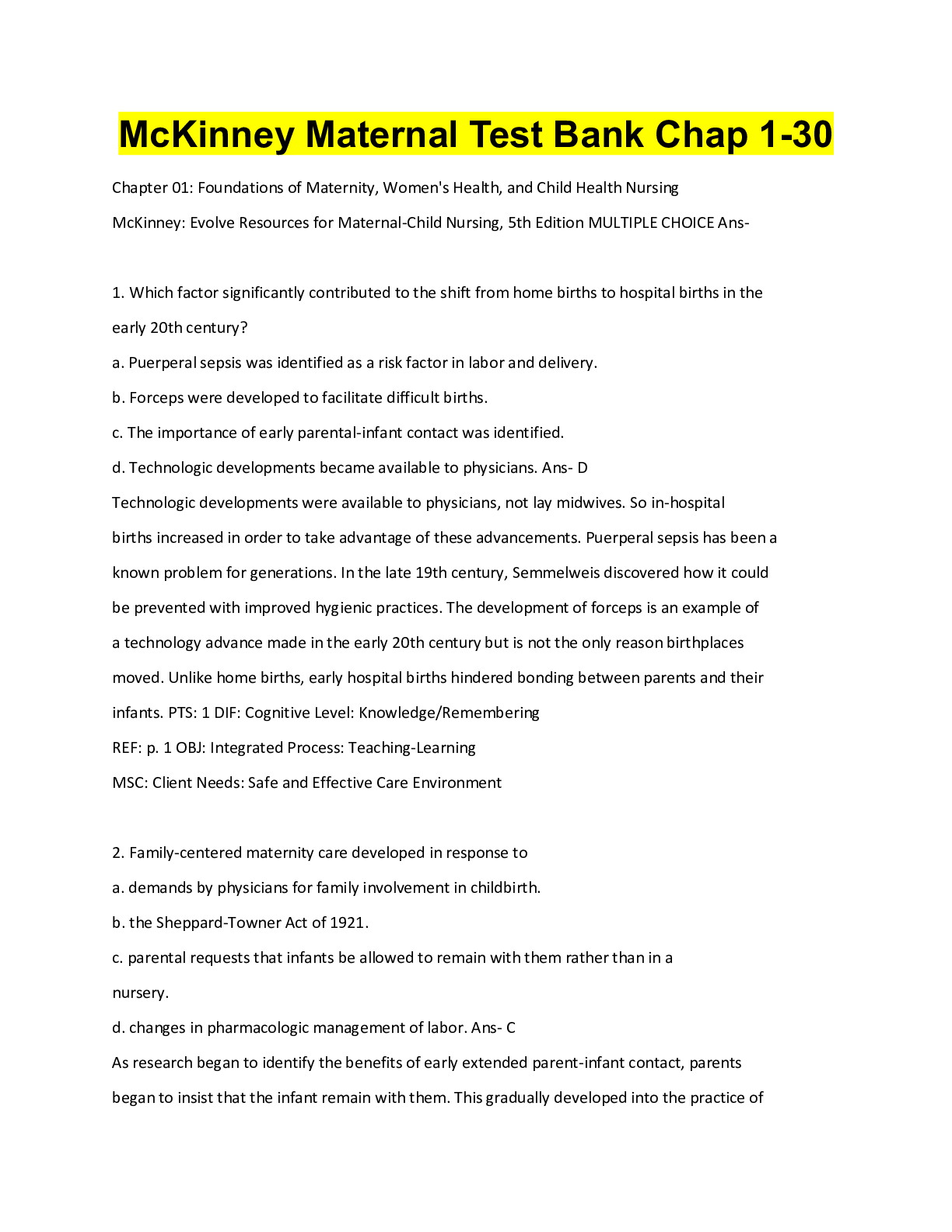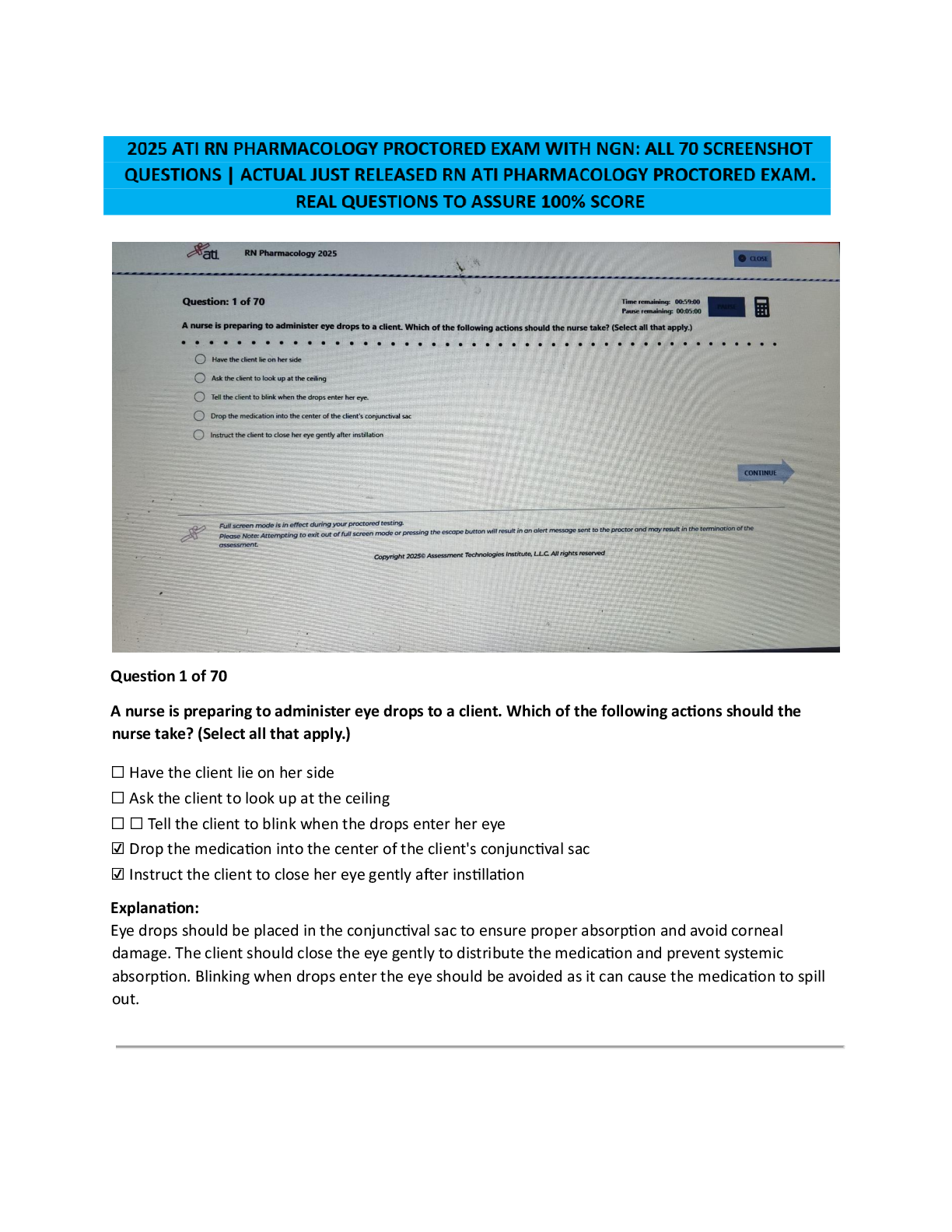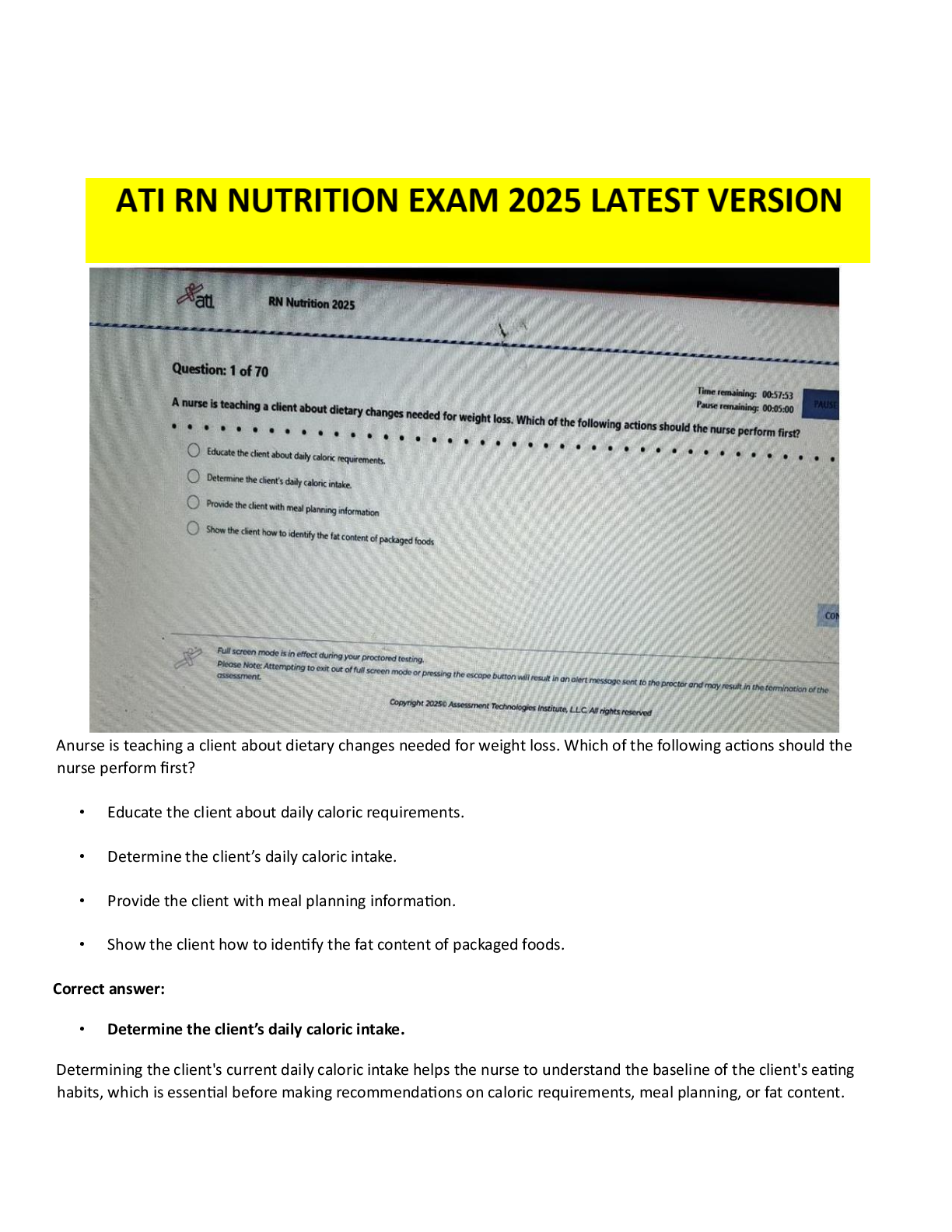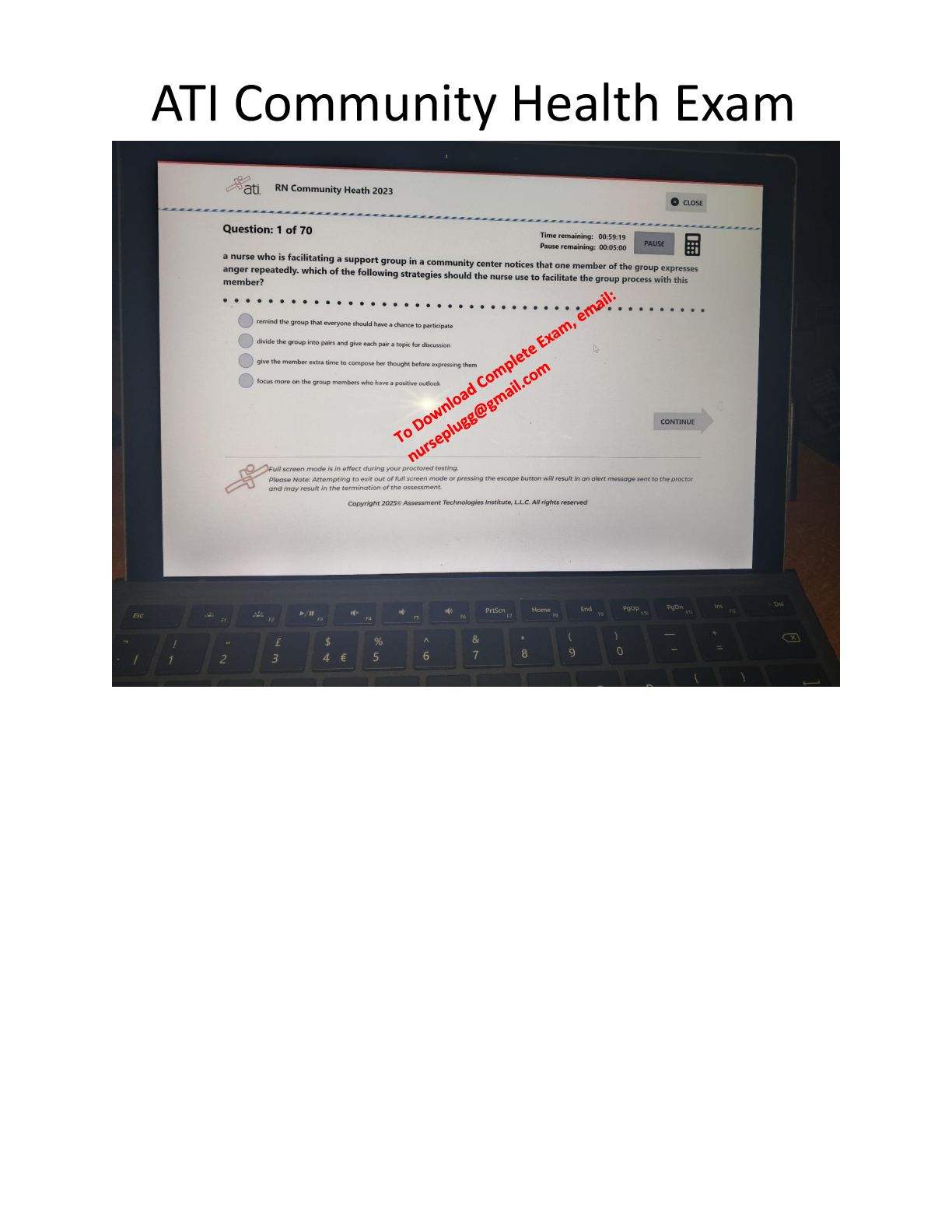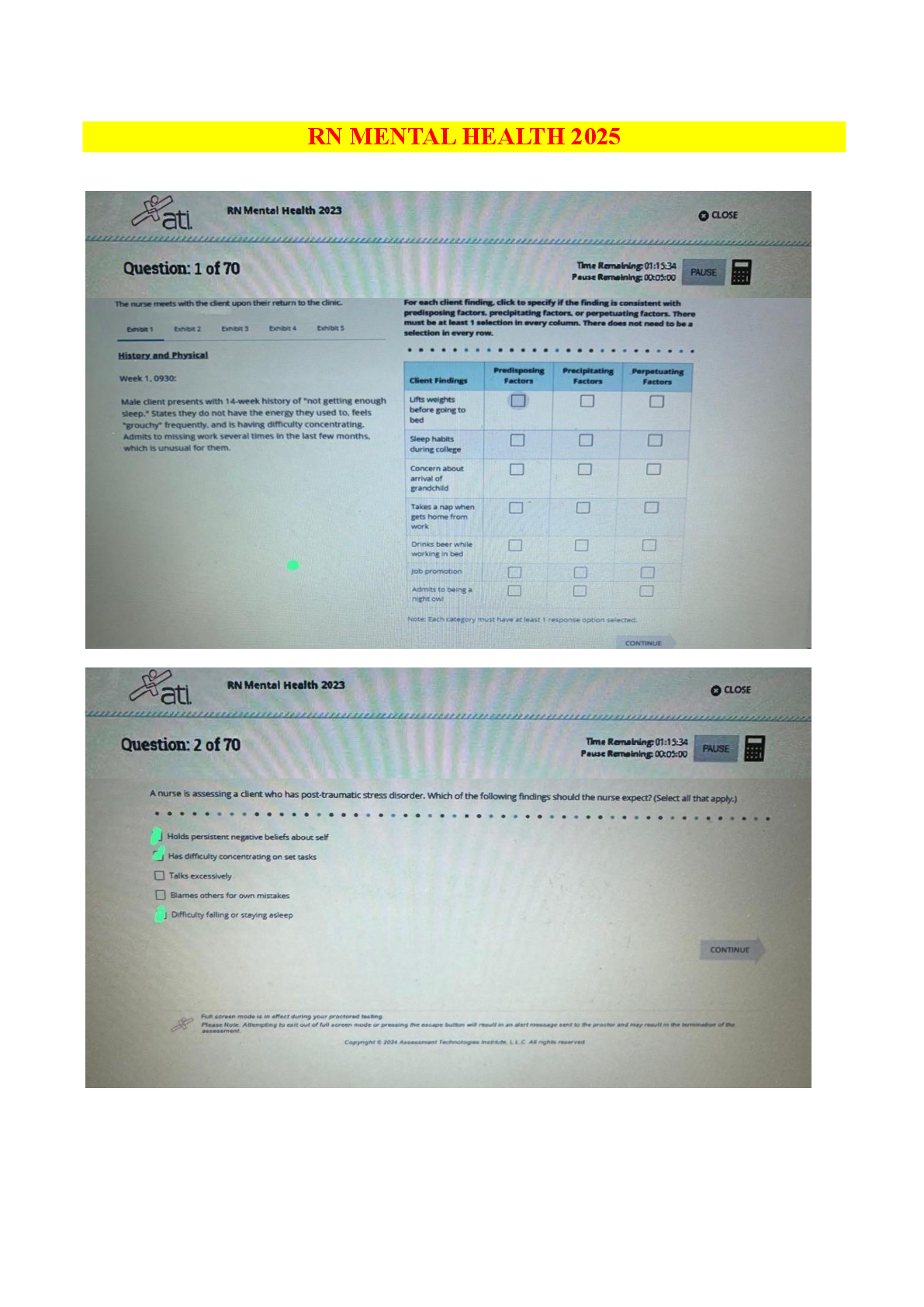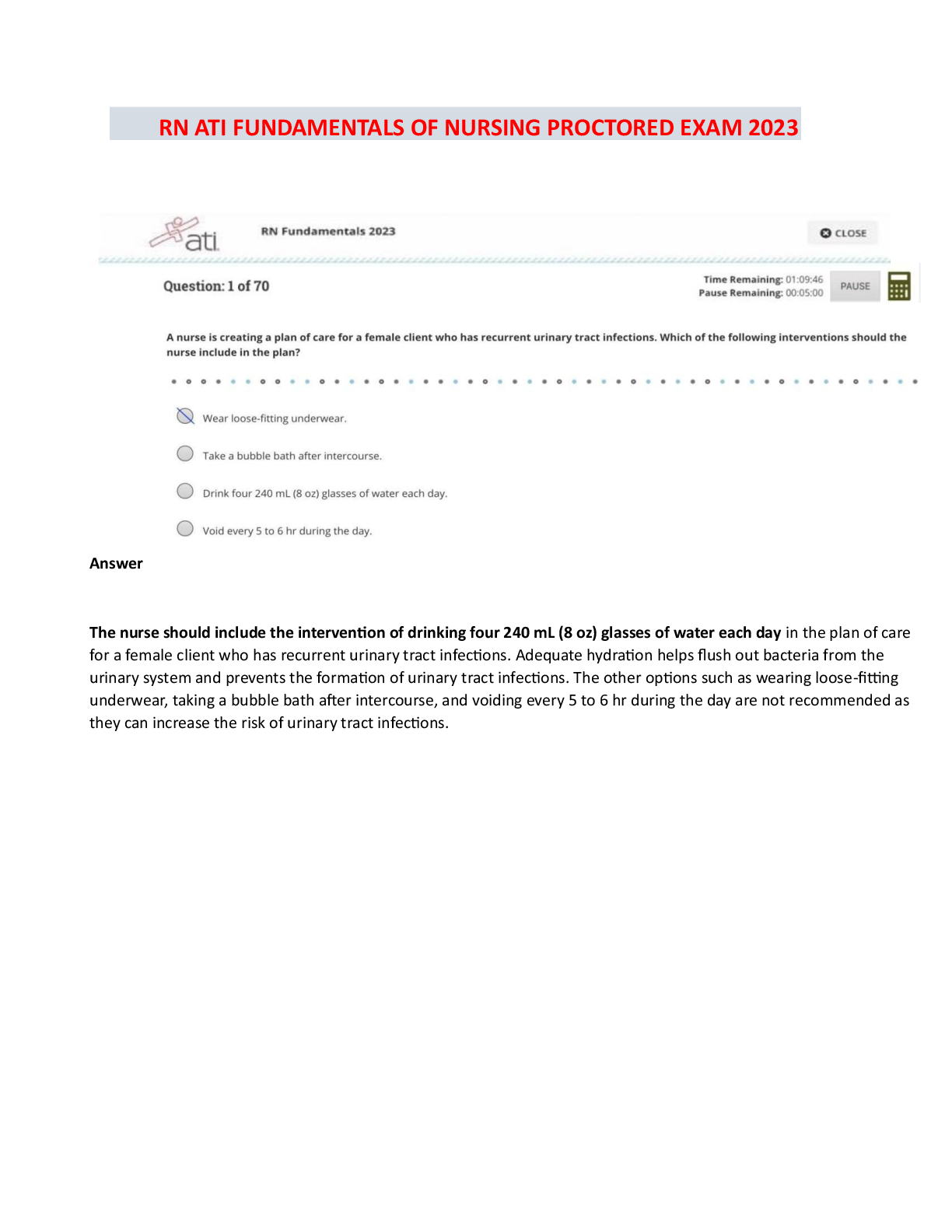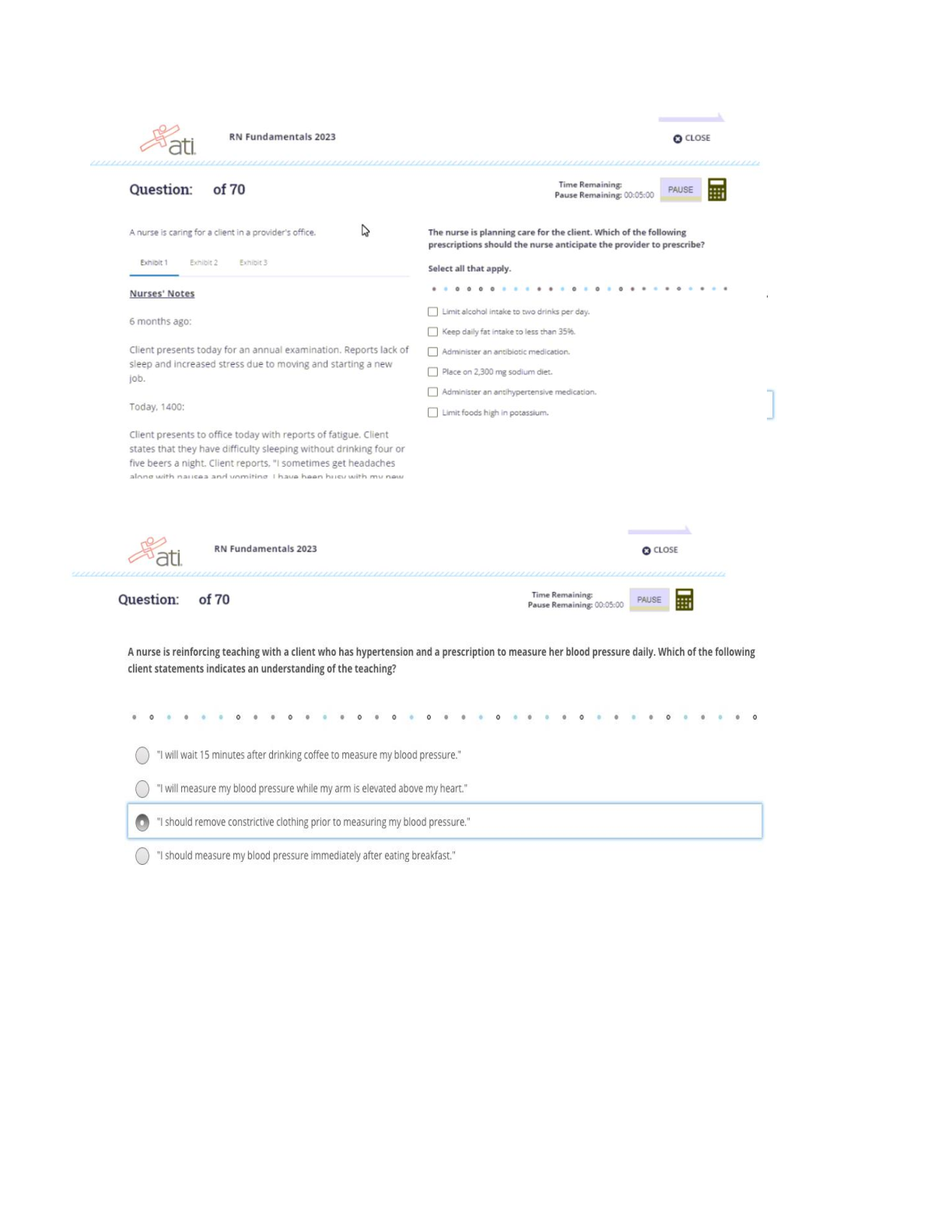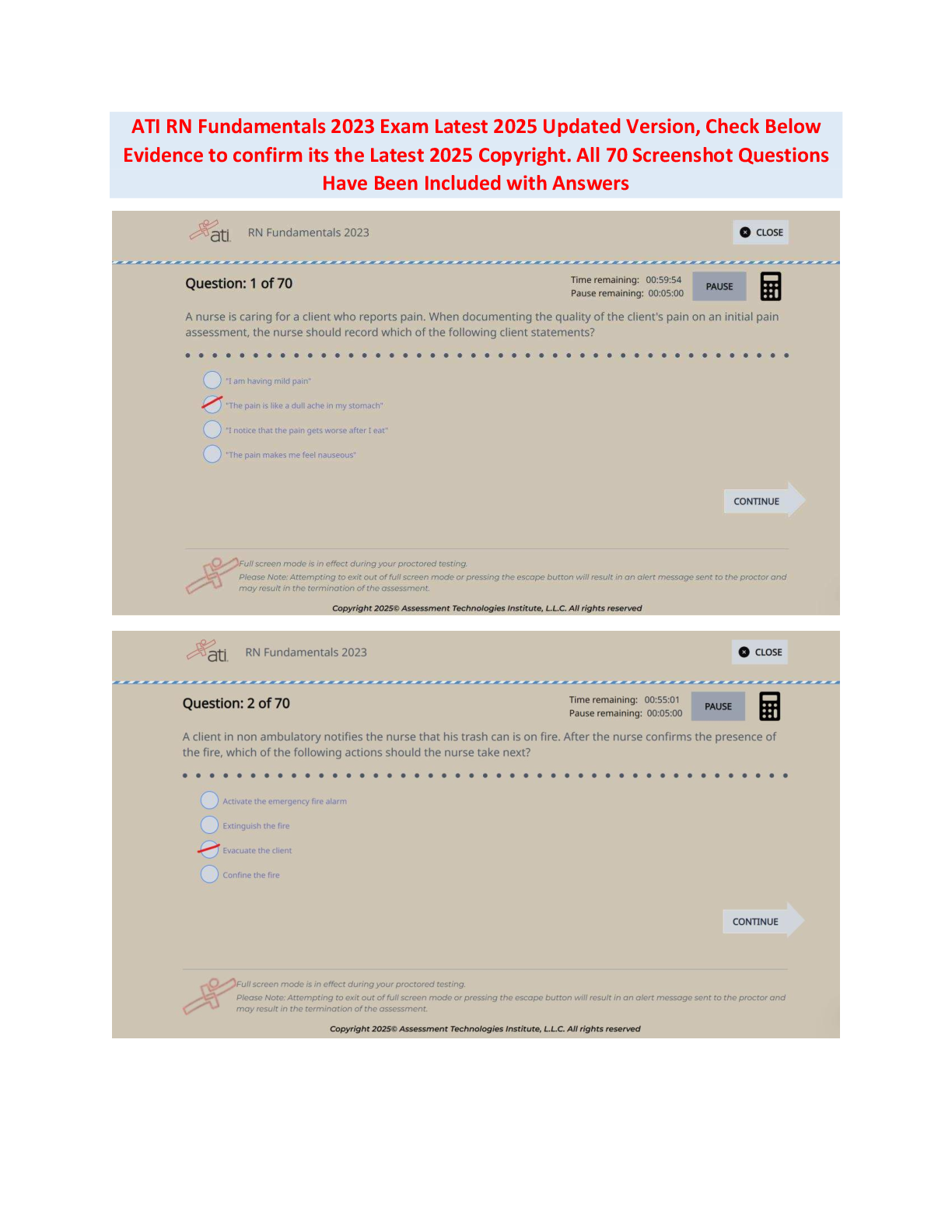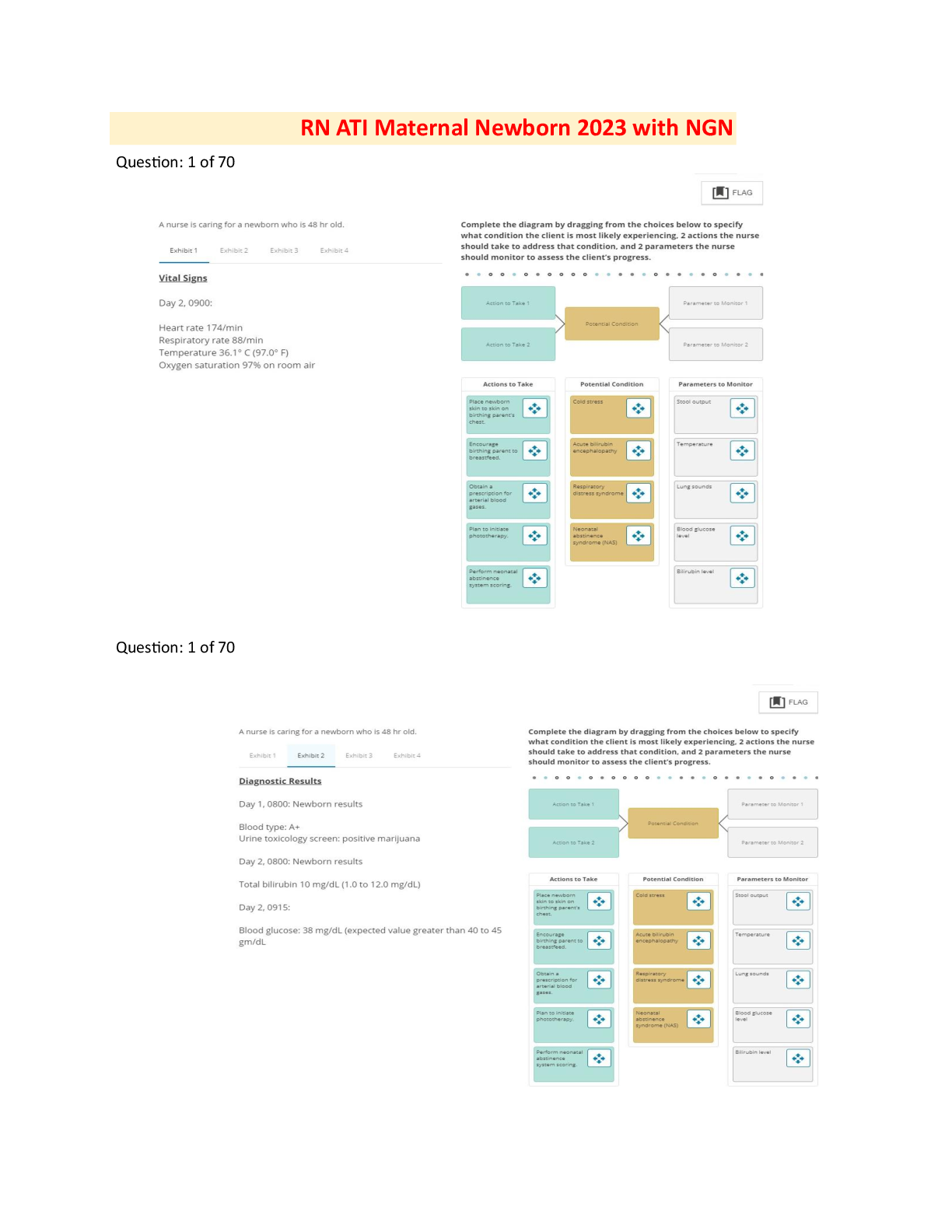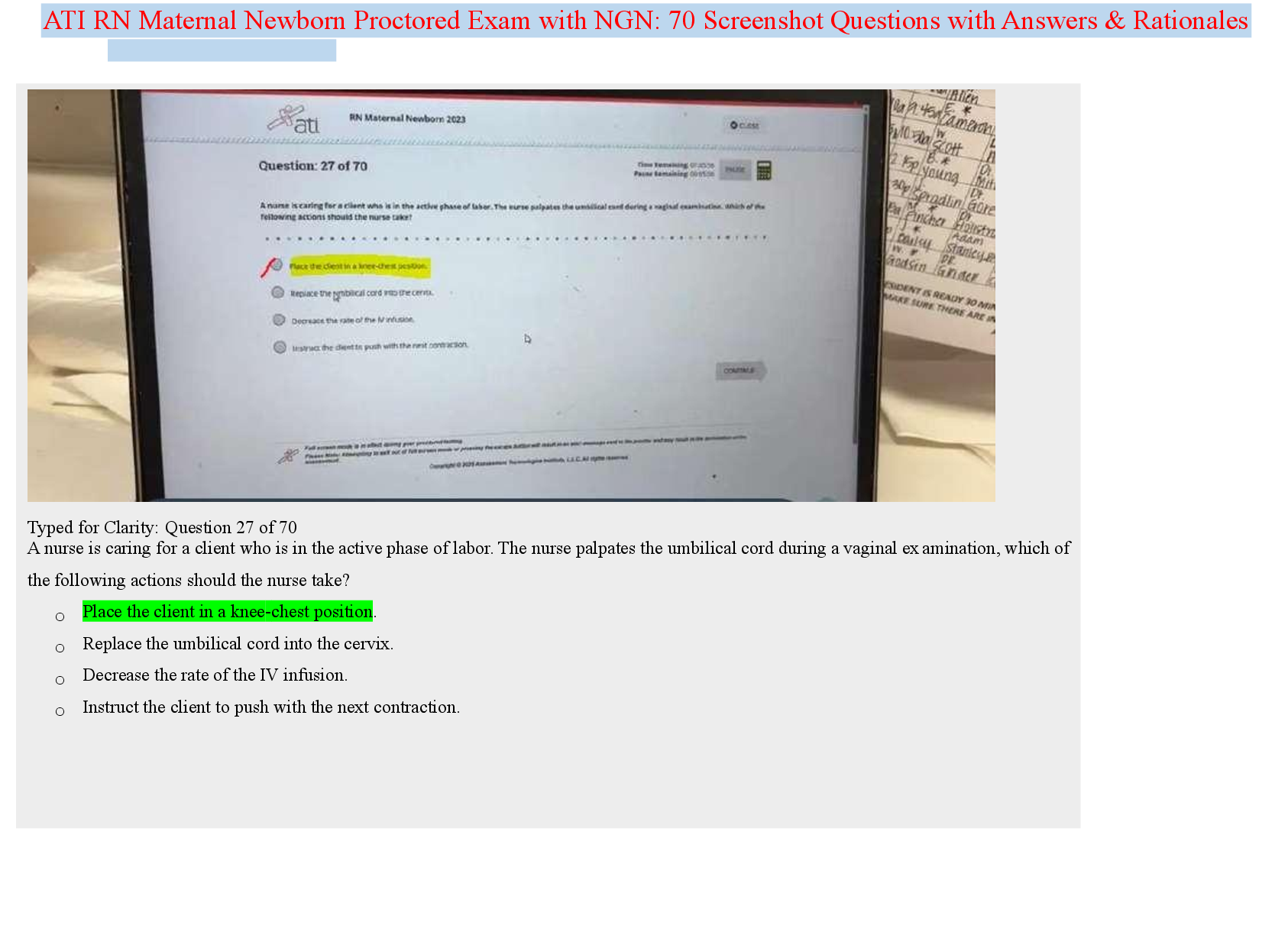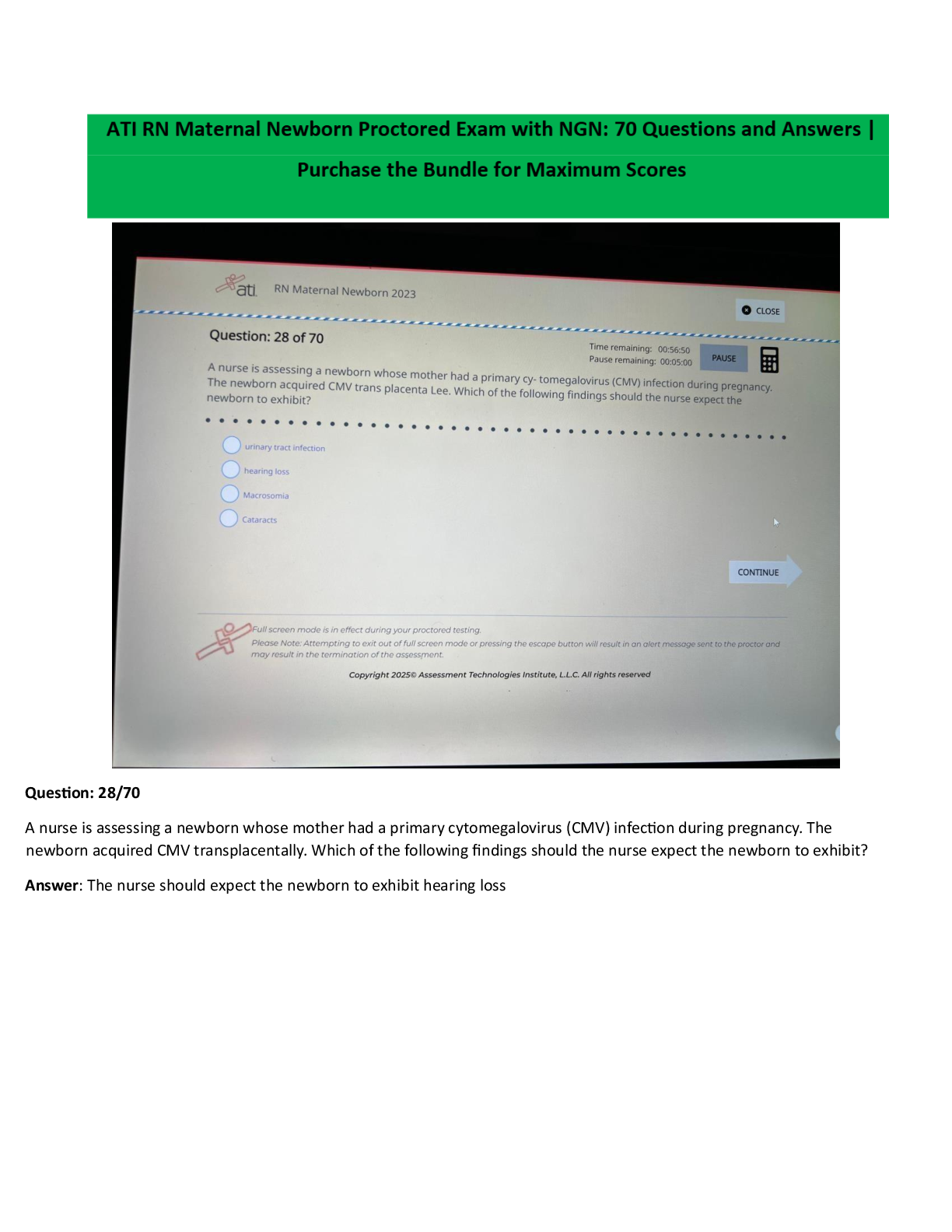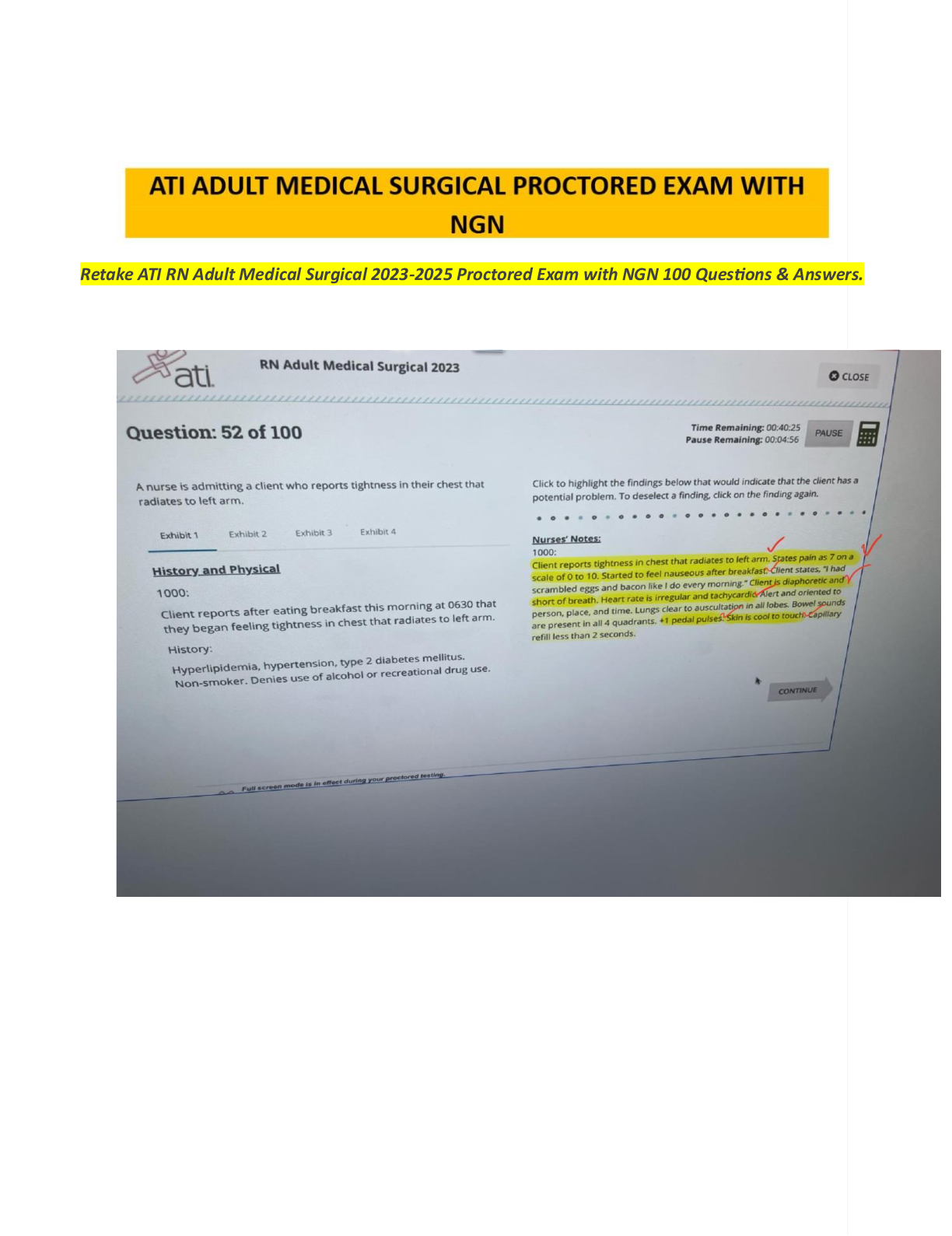ATI comprehensive Exit (Nclex 2019)
Document Content and Description Below
Do not delegate Ans- What you can EAT E-evaluate A-assess T-teach
Addison's & Cushings Ans- Addison's = down down down up down
Cushings= up up up down up
hypo/hypernatremia, hypo/hypertension, bloo
...
d volume, hypo/hyperkalemia, hypo/hyperglycemia
Addisons Ans�Better peripheral perfusion? Ans- EleVate Veins, DAngle Arteries
APGAR Ans- Appearance (all pink, pink and blue, blue (pale)
Pulse (>100, <100, absent)
Grimace (cough, grimace, no response)
Activity (flexed, flaccid, limp)
Respirations (strong cry, weak cry, absent)
Airborne precautions Ans- MTV or My chicken hez tbSmeasles(Rubeola), chickenpox (varicella) Herpes
zoster/shingles TB
Airborne precautions protective equip Ans- private room, neg pressure with 6-12 air exchanges/hr mask
& respirator N95 for TB
Droplet precautions Ans- spiderman! sepsis, scarlet fever, streptococcal pharyngitis, parvovirus,
pneumonia, pertussis,
influenza,
diptheria,
epiglottitis,
rubella (German measles),
mumps, meningitis, mycoplasma or meningeal pneumonia, adeNovirus
(Private room and mask)
Contact precaution Ans- MRS WHISE
protect visitors & caregivers when 3 ft of the pt.
Multidrug-resistant organisms
RSV, Shigella, Wound infections, Herpes simplex, Impetigo, Scabies, Enteric diseases caused by micro�organisms (C diff),
Gloves and gowns worn by the caregivers and visitors
Disposal of infectious dressing material into a single, nonporous bag without touching the outside of the
bag
PMGG= Private room/ share same illness, mask, gown and gloves
Skin infection Ans- VCHIPS
Varicella zoster
Cutaneous diptheria
Herpes simplez
Impetigo
Peduculosis
Scabies
Air or Pulmonary Embolism Ans- S/S chest pain, dyspnea, tachycardia, pale/cyanotic, sense of impending
doom. (turn pt to LEFT side and LOWER the head of bed.)
Woman in labor (un-reassuring FHR) Ans- (late decels, decreased variability, fetal bradycardia, etc) Turn
pt on Left side, give O2, stop pitocin, Increase IV fluids!
Tube feeding with decreased LOC Ans- Pt on Right side (promotes emptying of the stomach) Head of
bed elevated (prevent aspiration)
After lumbar puncture and oil based myelogram Ans- pt is flat SUPINE (prevent headache and leaking of
CSF)
Pt with heat stroke Ans- flat with legs elevated
during Continuous Bladder Irrigation (CBI) Ans- catheter is taped to the thigh. leg must be kept straight.
After Myringotomy Ans- position on the side of AFFECTED ear, allows drainage.
After Cateract surgery Ans- pt sleep on UNAFFECTED side with a night shield for 1-4 weeks
after Thyroidectomy Ans- low or semi-fowler's position, support head, neck and shoulders.
Infant with Spina Bifida Ans- Prone so that sac does not rupture
Buck's Traction (skin) Ans- elevate foot of bed for counter traction
After total hip replacement Ans- don't sleep on side of surgery, don't flex hip more than 45-60 degress,
don't elevate Head Of Bed more than 45 degrees. Maintain hip abduction by separating thighs with
pillows.
Prolapsed cord Ans- Knee to chest or Trendelenburg
oxygen 8 to 10 L
Cleft Lip Ans- position on back or in infant seat to prevent trauma to the suture line. while feeding hold
in upright position.
To prevent dumping syndrome Ans- (post operative ulcer/stomach surgeries) eat in reclining position.
Lie down after meals for 20-30 min. also restrict fluids during meals, low CHO and fiber diet. small,
frequent meals.
AKA (above knee amputation) Ans- elevate for first 24 hours on pillow. position prone daily to maintain
hip extension.
BKA (below knee amputation) Ans- foot of bed elevated for first 24 hours. position prone to provide hip
extension.
detached retina Ans- area of detachment should be in the dependent position
administration of enema Ans- pt should be left side lying (Sim's) with knee flexed.
After supratentorial surgery Ans- (incision behind hairline on forhead) elevate HOB 30-40 degrees
After infratentorial surgery Ans- (incision at the nape of neck) position pt flat and lateral on either side.
During internal radiation Ans- on bed rest while implant in place
Autonomic Dysreflexia/Hyperreflexia Ans- S/S pounding headache, profuse sweating, nasal congestion,
chills, bradycardia, hypertension. Place client in sitting position (elevate HOB) FIRST!
Shock Ans- bedrest with extremities elevated 20 degrees. knees straight, head slightly elevated
(modified Trendelenberg)
Head Injury Ans- elevate HOB 30 degrees to decrease ICP
Peritoneal Dialysis (when outflow is inadequate) Ans- turn pt from side to side BEFORE checking for
kinks in tubing
Lumbar Puncture Ans- After the procedure, the pt should be supine for 4-12 hours as prescribed.
Myesthenia Gravis Ans- worsens with exercise and improves with rest
Myesthenia Gravis Ans- a positive reaction to Tensilon---will improve symptoms
Cholinergic Crisis Ans- Caused by excessive medication ---stop giving Tensilon...will make it worse.
Liver biopsy (prior) Ans- must have lab results for prothrombin time
Myxedema/ hypothyroidism Ans- slowed physical and mental function, sensitivity to cold, dry skin and
hair.
Grave's Disease/ hyperthyroidism Ans- accelerated physical and mental function. Sensitivity to heat.
Fine/soft hair.
Thyroid storm Ans- increased temp, pulse and HTN
Post-Thyroidectomy Ans- semi-fowler's. Prevent neck flexion/hyperextension. Trach at bedside
Hypo-parathyroid Ans- CATS---Convulsions, Arrhythmias, Tetany, Spasms, Stridor. (decreased calcium)
give high calcium, low phosphorus diet
Hyper-parathyroid Ans- fatigue, muscle weakness, renal calculi, back and joint pain (increased calcium)
give a low calcium high phosphorous diet
Hypovolemia Ans- increased temp, rapid/weak pulse, increase respiration, hypotension, anxiety. Urine
specific gravity >1.030
Hypervolemia Ans- bounding pulse, SOB, dyspnea, rales/crackles, peripheral edema, HTN, urine specific
gravity <1.010. semi fowler's
Diabetes insipidus (decreased ADH) Ans- excessive urine output and thirst, dehydration, weakness,
administer Pitressin
SIADH (increased ADH) Ans- change in LOC, decreased deep tendon reflexes, tachycardia. N/V HA
administer Declomycin, diuretics
hypokalemia Ans- muscle weakness, dysrhythmias, increase K (rasins bananas apricots, oranges, beans,
potatoes, carrots, celery)
Hypokalemia Strip changes Ans�Hyperkalemia Ans- MURDER Muscle weakness, Urine (olig, anuria) Resp depression, decreased cardiac
contractility, ECG changes, reflexes
hyperkalemia strip changes Ans�Hyponatremia Ans- nausea, muscle cramps, increased ICP, muscular twitching, convulsions. give osmotic
diuretics (Mannitol) and fluids
Hypernatremia Ans- increased temp, weakness, disorientation, dilusions, hypotension, tachycardia. give
hypotonic solution.
Hypocalcemia Ans- CATS Convulsions, Arrythmias, Tetany, spasms and stridor
Hypercalcemia Ans- muscle weakness, lack of coordination, abdominal pain, confusion, absent tendon
reflexes, shallow respirations, emergency!
Hypo Mg Ans- Tremors, tetany, seizures, dysthythmias, depression, confusion, dysphagia, (dig toxicity)
Hyper Mg Ans- depresses the CNS. Hypotension, facial flushing, muscle weakness, absent deep tendon
reflexes, shallow respirations. EMERGENCY
Addison's Ans- Hypo Na, Hyper K, Hypoglycemia, dark pigmentation, decreased resistance to stress fx,
alopecia, weight loss. GI stress.
Cushings Ans- Hyper Na, Hypo K, hyperglycemia, prone to infection, muscle wasting, weakness, edema,
HTN, hirsutism, moonface/buffalo hump
Addesonian crisis Ans- N/V confusion, abdominal pain, extreme weakness, hypoglycemia, dehydration,
decreased BP
Pheochromocytoma Ans- hypersecretion of epi/norepi. persistent HTN, increased HR, hyperglycemia,
diaphoresis, tremor, pounding HA; avoid stress, frequent bathing and rest breaks, avoid cold and
stimulating foods (surgery to remove tumor)
Tetrology of Fallot Ans- DROP (Defect, septal, Right ventricular hypertrophy, Overriding aortas,
Pulmonary stenosis)
Autonomic Dysreflexia Ans- (potentially life threatening emergency!) HOB elevate 90 degrees, loosen
constrictive clothing, assess for full bladder or bowel impaction, (trigger) administer antihypertensives
(may cause stroke, MI, seizure)
FHR patterns for OB Ans- Think VEAL CHOP!
V-variable decels; C- cord compression caused
E-early decels; H- head compression caused
A-accels; O-okay, no problem
L- late decels; P- placental insufficiency, can't fill
what to check with pregnancy Ans- Never check the monitor or machine as a first action. Always assess
the patient first. Ex.. listen to fetal heart tones with stethoscope.
Position of the baby by fetal heart sounds Ans- Posterior --heard at sides
Anterior---midline by unbilicus and side
Breech- high up in the fundus near umbilicus
Vertex- by the symphysis pubis.
Ventilatory alarms Ans- HOLD
High alarm--Obstruction due to secretions, kink, pt cough etc
Low alarm--Disconnection, leak, etc
ICP and Shock Ans- ICP- Increased BP, decreased pulse, decreased resp
Shock--Decreased BP, increased pulse, increased resp
Cor pumonae Ans- Right sided heart failure caused by left ventricular failure (edema, jugular vein
distention)
Heroin withdrawal neonate Ans- irritable, poor sucking
brachial pulse Ans- pulse area on an infant
lead poisoning Ans- test at 12 months of age
Before starting IV antibiotics Ans- obtain cultures!
pt with leukemia may have Ans- epistaxis due to low platelets
when a pt comes in and is in active labor Ans- first action of nurse is to listen to fetal heart tones/rate
for phobias Ans- use systematic desensitization
NCLEX answer tips Ans- choose assessment first! (assess, collect, auscu
[Show More]
Last updated: 2 years ago
Preview 1 out of 28 pages
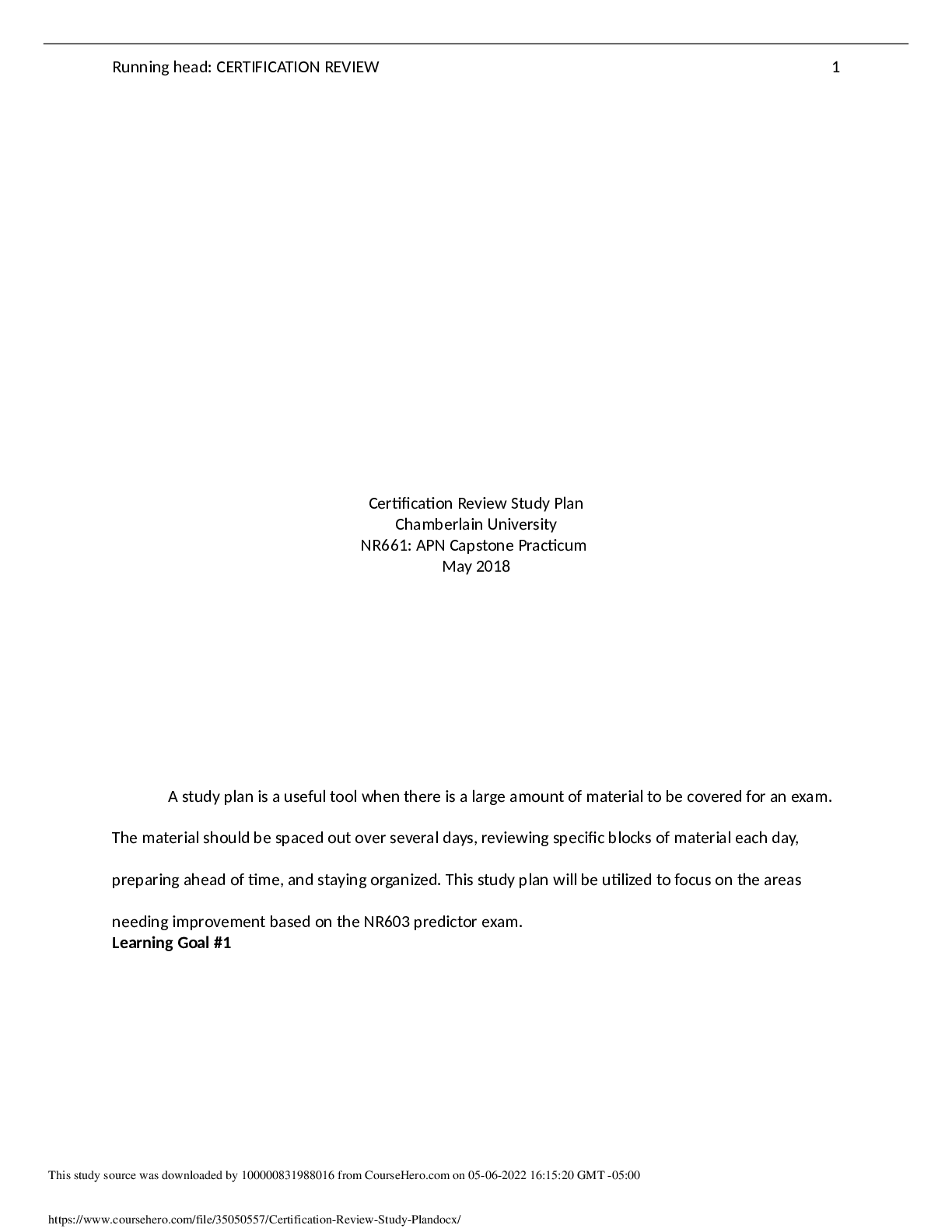
.png)


 Lots of Pics.png)

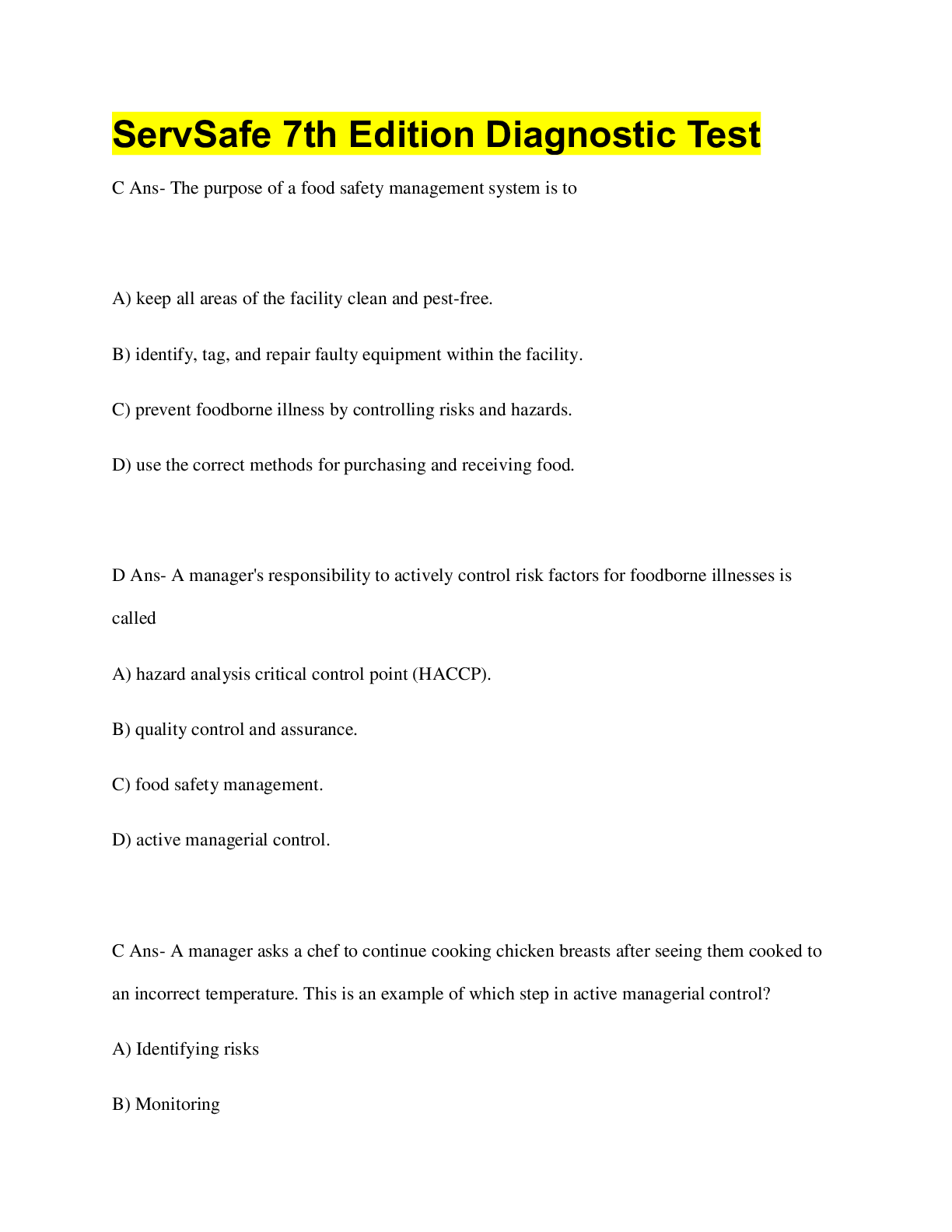


.png)
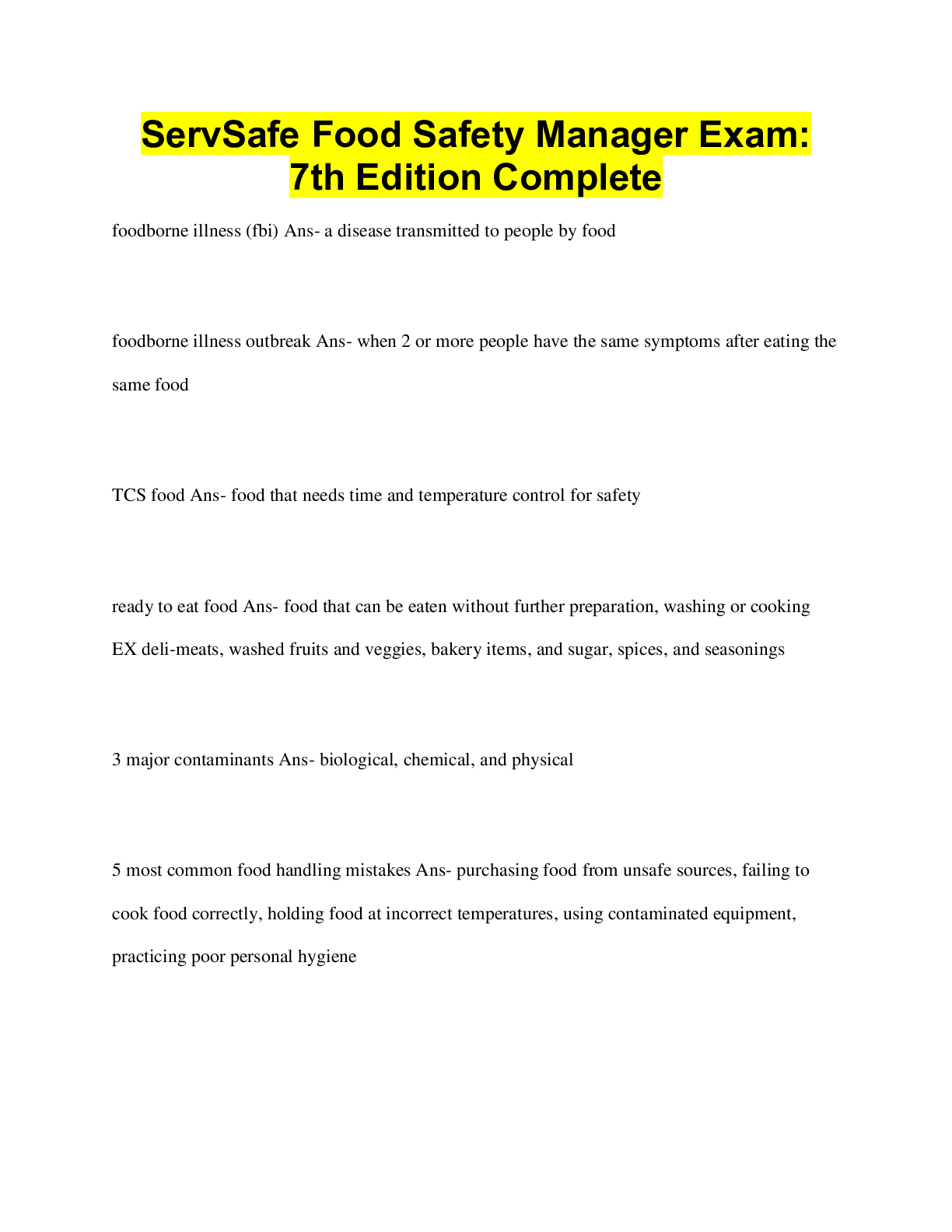
.png)

